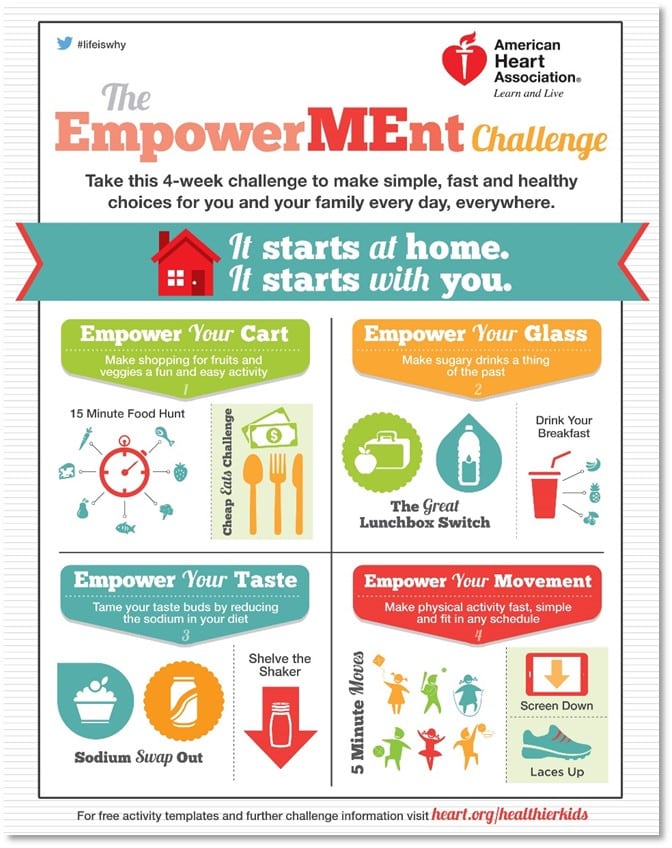
By Krisleigh Hoermann, director of operations, digital and social media consultant at American Heart Association, and Alexandra Paterson, national communications lead, Kids Market, department of public and media relations, American Heart Association National Center.
Childhood obesity is one of the chief health concerns in the United States. In 2013, the American Heart Association|American Stroke Association (AHA/ASA) shifted its focus from PR programs solely supporting the group’s original mission of preventing heart disease, to engaging segments of the population to expand the fight against both heart disease and stroke. Part of the change was introducing a kids market. One of the results of adding this new market segment was the creation of National Childhood Obesity Awareness Month, which kicked off in September 2014.
THE GOALS
The prevention of childhood obesity starts at home. To help families understand the risks associated with childhood obesity the AHA/ASA created the EmpowerMEnt Challenge.
Since there was little budget dedicated to the initiative, the team leveraged existing materials and repurposed them to create an engaging challenge.
Fortunately, guidelines for avoiding heart disease and stroke in adults are similar to those for children. The four, week-long challenges, intended for the entire family, included: increasing fruit and vegetable consumption; reducing consumption of sugar-sweetened beverages; reducing sodium intake; and increasing physical activity. By the end of the month, the goal was to help family members feel better equipped to live heart-healthy lives.
The campaign had four main objectives:
- Increase awareness and engagement of health living among families online, especially around childhood obesity
- Boost traffic to AHA resources, and overall engagement of those assets
- Earn challenge participants online and increase overall online engagement
- Engage a national media sponsor, and at least one online influencer
THE EXECUTION
At the beginning of every good PR strategy is a solid, evidence-based target audience. The AHA/ASA focused on parents and general caregivers, like grandparents, aunts, uncles, even teachers and school administrators. Children (ages 6-9) were a secondary focus in the hope that they would feel empowered through the activities and help their families make lasting changes at home.
“This event was vital to the continued growth and outreach for our newly developed market area focused on kids,” said Matthew Bannister, executive VP of communications for the American Heart Association. “The month allowed us to interact with consumers in a way we haven’t before. We wanted to meet them where they are—be with them in their home, in the grocery store, as they exercised and online—to help motivate and support them.”
To help make the event appealing and fun for consumers, the team created a series of sharable graphics that included an event illustration, Facebook cover image, widgets, thumbnails and banners.
To host the challenge, the team created the EmpowerMEnt Challenge Facebook Event page for ongoing engagement and encouragement, and linked it to the AHA/ASA’s healthier kids website for people who wanted to get more information.
AHA/ASA local communications staffs across the country were armed with quality promotional materials to assist PR and social media efforts.
Engaging with multicultural audiences also was top-of-mind, so providing Spanish-language materials alongside English assets was crucial.
In addition to the materials available to local communications staffs, the national PR team worked closely with NBC News to create a media-ready toolkit for affiliate and Owned & Operated markets that included canned on-air segments they could run during September.
As part of this package, four science-relevant segments were created that focused on childhood obesity. The segments were 90 seconds long and broken down by various themes throughout the month. Each video was hosted on AHA/ASA’s YouTube site for easy access to the stations.
To foster organic conversations within the group’s social channels, the team held a series of Twitter Chats offering tips related to the week’s theme that provided additional tools and program information to support people during their month-long journey.
THE RESULTS
During the EmpowerMEnt Challenge, the Facebook segment of the Challenge earned more than 1,200 participants, beating the original goal by more than 500 percent. The Challenge itself reached 113.9 million consumers, with more than 6,800 views and 9,800 mentions. The website saw a 69 percent increase in page views. Numerous national media placements and influencer engagements were instrumental in the success of the campaign, such as Huffington Post, The TODAY Show and Child magazine.
“With the new focus on the kids market, the challenge created a community that could be the cornerstone for initiatives moving forward,” Bannister added. “The way the event was executed helped elevate the brand and put this new market on the map.”
LESSONS LEARNED
1. Start small; don’t overthink. By setting concrete goals and using proven tactics you can create a successful campaign to build on in the future. It gives you plenty of room to test and find out what works for your program.
2. Bring in your key players early. By having key departments at the table, we were able to ensure the campaign would be successful. Since we’re eager to expand the program we’ve decided to change the name to mesh with our branding—Life is Why Family Health Challenge.
3. Create a clear influencer strategy. Know who the influencers are and how they interact with the market before reaching out to them. It’s always better to approach influencers after you’ve built a good relationship than before. Make sure you understand FTC regulations, too. [See Tips for Driving an Influencer Strategy]
4. Allow budget and time to produce bilingual materials if your target audience is bilingual. If your target market speaks more than one language, co-create assets that work across all your audiences. You’ll be more likely to get increased participation.
5. Produce quality video for social sharing and broadcast. You don’t have to spend thousands of dollars on video, but make sure it has good lighting and sound and delivers an engaging message.
6. Meet your consumers where they are. Engage with them. We believe our campaign was successful because we talked to our constituents. We were a part of the conversation, not just pushing messages. No one wants a friend who always talks himself. Keep that in mind.

Tips for Driving an Influencer Strategy
1. Understand FTC Guidelines. The FTC has strict guidelines on what you can and cannot do with influencers in the social space. For example, be sure the blogger includes a disclaimer showing that he or she received a product for free. It must be clearly displayed for the reader. Twitter endorsements should also include a clearly visible disclosure, like #Ad or #sponsoredby(company name) at the beginning of a tweet.
2. Find your influencers. Find influencers who have well-connected ties to your target audience. Use a listening tool, like Sprinklr, Twitter search and Technorati, to identify your core influencers.
3. Build a relationship. Before you contact influencers to make an ask, start engaging them in social media. They are more likely to want to participate with an organization that already is engaging with them.
4. Make it easy. Set clear expectations, and make it as easy as possible to work with your brand.
5. Be authentic. What’s in it for the influencers? Be honest and build a real, authentic relationship.
Krisleigh Hoermann, director of operations, digital and social media consultant at American Heart Association, wrote this sidebar.
CONTACT: Krisleigh Hoermann, [email protected]; Alexandra Paterson, [email protected]
This article originally appeared in the June 13, 2015 issue of PR News. Read more subscriber-only content by becoming a PR News subscriber today.
